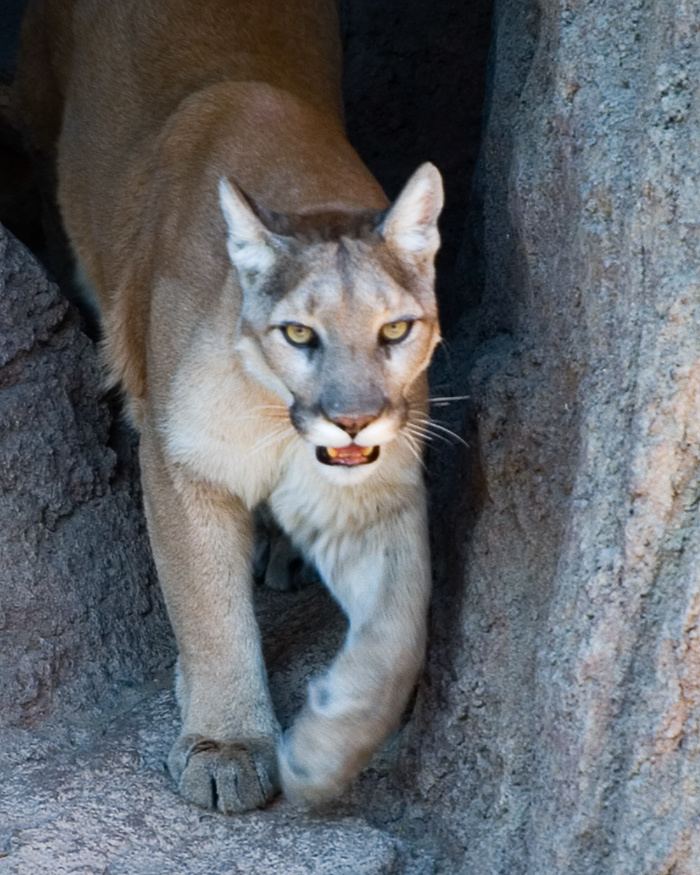Phylum Chordata Tribe Acinonychini | ||
 | ||
Puma is a genus in Felidae that contains the cougar (also known as the puma, among other names) and the jaguarundi, and may also include several poorly known Old World fossil representatives (for example, Puma pardoides, or "Owen's panther," a large cougar-like cat of Eurasia's Pliocene). In addition to these potential Old World fossil there are a couple of New World fossil representatives such as Puma pumoides and possibly the two species of the so-called "American cheetah".
Contents
Description
The puma is a large, secretive cat. They are also commonly known as cougars and mountain lions, and are able to reach larger sizes than other "big" cat individuals. Though despite their large size, it has been believed that they are more closely related to smaller feline species. There are 7 subspecies of puma, all of which have similar characteristics but tend to vary in color and size. Pumas are thought to be one of the most adaptable of felines on the American continents, for the fact that they are found in a variety of different habitats unlike other various cat species.
Distribution and habitat
Members of the puma genus are primarily found in the mountains of North and South America, where a majority of individuals can be found in rocky crags and pastures slowly down lower than the slopes grazing herbivores inhabit. Though they choose to inhabit those kinds of areas, they are highly adaptive and can really be found in a large variety of habitats including; forests, tropical jungle, grasslands, and even arid desert regions. Unfortunately, with the expansion of human settlements and land clearance, the cats are being pushed into smaller areas of habitat. Despite them being pushed into more hostile mountain areas, it is believed that their high adaptability allows for members of the genus to avoid disappearing from the wild forever.
Anatomy and appearance
Subspecies of the puma genus include cats that are the fourth largest in the cat family. Adult males can reach around 7.9 feet from nose to tail, and a body weight averaging between 115–220 lbs. Females can reach around 6.7 ft from nose to tail, and a body weight averaging between 64 and 141 lbs. They also have tails ranging from 25 to 37 inches of their body length. The heads of the cats are round, with erect ears. It has powerful forequarters, neck, jaw which help grasp and hold its prey. They have four retractable claws on their forepaws, and also their hind paws.
The majority of pumas are found in more mountainous regions, therefore they have a thick fur coat to help retain body heat during freezing winters. Depending on subspecies and the location of their habitat, the puma's fur varies in color from brown-yellow to grey-red. Individuals who live in colder climates have coats that are more grey than individuals living in warmer climates with a more red color to their coat. Pumas are incredibly powerful predators with muscular hind legs, which are slightly longer and stronger than the front, that enable them to be great leapers. They are able to leap as high as 18 ft into the air and as far as 40–45 ft horizontally. They can reach speeds of up to 40–50 mph, but they are much better adapted for short and powerful sprints to catch their prey.
Behavior and lifestyle
Members of the genus live solitarily, with the exception of the time cubs spend with their mothers. Individuals cover a large home range searching food, covering a distance of about 80 square miles during the summers and 40 square miles during the winters. They are also able to hunt during the night just as effectively as they can during the day. Members of the genus are also known to make a variety of different sounds, particularly used when warning another individual away from their territory or during the mating season when looking for a mate.
Diet
Members of this genus are large and powerful carnivores. The majority of their diet includes small animals such as mice, rats, birds, fish, and rabbits. Larger individuals are able to catch larger prey such as bighorn sheep, deer, guanaco, mountain goats, raccoons and coati. They occasionally take livestock in areas with high human population.
Reproduction and life cycles
Breeding season normally occurs between December and March, with a three-month gestation period resulting in a litter size of up to six cubs. After mating, male and female will part ways; the male will continue on to mate with other females for the duration of the mating season, while the female will care for the cubs on her own. Like most other felines, cubs are born blind and remain completely helpless for approximately 2 weeks until their eyes open. Cubs are born with spots and will eventually lose all of them as they reach adulthood. The spots allow the cubs to camouflage better from predators. Cubs are able to eat solid food when they reach 2–3 months of age and remain with their mother for about a year. The life expectancy of individuals in the wild averages 12 years, but can reach up to 25 years in captivity.
Conservation
Although they have been pushed into smaller habitats by human settlement expansion, members of the genus have been designated least-concern species by the IUCN, indicating low risk of becoming extinct in their natural environments in the near future. This is due to their high adaptiveness to changing habitat conditions. In fact, many feel that it is the pumas' ability to adapt to different environments that explains their current numbers.
